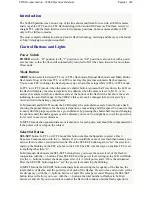
20
/ 21
7. Explanation of Terms
1.
Dual-stream
Dual-stream use one way high rate stream for local HD storage, such as QCIF / CIF / 2CIF /
DCIF / 4CIF encoding, and one way low bit rate stream for network transmission, such as QCIF /
CIF encoding, taking into account both of local storage and remote network transmission
。
Dual-stream can achieve local transmission and remote transmission two different needs of
bandwidth stream, local transmission using high stream can achieve higher resolution of video
storage, remote transmission using lower stream to accommodate CDMA / ADSL and other
networks to achieve higher image fluency.
2.
DDNS
DDNS (Dynamic Domain Name Server) is that map the dynamic IP address of the user to a
fixed domain name resolution service, users connect to the network each time the client program
will sent the dynamic IP address of the host server program to the service provider located on the
host through information transfer, services program is responsible for providing DNS service and
realize dynamic domain name resolution. It means that DDNS capture every time a user changes
the IP address, then correspond it to the domain name, so that other Internet users can
communicate through the domain name.
3.
UPNP
UPnP, Universal Plug and Play
,
is a set of protocols collectively known, can not be simply
interpreted as UPnP = "automatic port mapping." In BitComet download, UPnP contains two
layers of meaning:
1)
For a computer within the network,UPNP of BitComet is a quick way to discover the IP
device on the network. Via UPNP function, the above ports could be mapped
automatically in the router.
2)
Gateway or network firewall module of router began to open the port to other computers
on the Internet.
UPNP stands for Universal Plug and Play protocol, in order to realize the architecture of
equal network connection of computer and intelligent electrical equipment. The conversion within
the network address and network address is based on this agreement, so as long as our router
supports upnp, and we use xp operating system that support this protocol, then we can take to
improve the transmission speed point to point.
Enter the router's setup interface, if your router supports upnp and then forwarding rules tab
you will see upnp settings options (different routers may be different), in this option, we choose to
enable upnp, and then we restart the routers. Then we completed the router's settings.
4.
NTP
Network Time Protocol (NTP) is a protocol used to synchronize computer time, which can
make the computer do its webcam or clock source (such as quartz, GPS, etc.) synchronization,
which can provide high accuracy of time correction (on the LAN and standard room is less than a
millisecond, the WAN tens of milliseconds), and can be identified via an encrypted way to prevent
malicious protocol attacks.


































